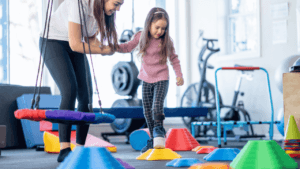
Kids’ Health Physical Fitness for Children Boost
Introducing Physical Fitness for Children and active lifestyle is key to their overall well-being. Physical fitness plays a crucial role in children’s development, promoting their physical, mental, and emotional health. In this article, we will explore the importance of physical activity for children, provide guidelines for incorporating exercise into their daily routines, and offer tips for encouraging an active lifestyle.
Key Takeaways:
- Physical Fitness for Children health and well-being.
- Children should engage in at least 60 minutes of physical activity every day.
- Physical activity promotes the development of healthy bones, muscles, and joints.
- Regular exercise improves coordination, balance, and brain development.
- Parents, caregivers, and schools play a crucial role in encouraging children to be physically active.
Benefits of Physical Activity for Children
Engaging in regular physical activity brings numerous benefits to children’s health and overall well-being. Physical activity helps in the development of healthy bones, muscles, and joints. It strengthens the heart and lungs, improves coordination, muscle control, and body flexibility. Regular exercise also helps children maintain a healthy body weight, improves balance and posture, and enhances brain development, leading to better concentration and thinking skills. Moreover, children who engage in physical activity are less likely to develop chronic diseases such as heart disease and type 2 diabetes.
Key Benefits of Physical Activity for Children:
- Development of healthy bones, muscles, and joints
- Improved heart and lung function
- Enhanced coordination, muscle control, and body flexibility
- Maintenance of a healthy body weight
- Improved balance and posture
- Enhanced brain development, concentration, and thinking skills
- Reduced risk of chronic diseases like heart disease and type 2 diabetes
It is crucial to prioritize physical fitness for children by incorporating regular exercise and engaging in age-appropriate activities. By doing so, children can experience the lifelong benefits of an active and healthy lifestyle.
Guidelines for Physical Activity in Children
Ensuring that children engage in regular physical activity is crucial for their physical fitness and overall wellness. The recommended guidelines suggest that children aged 5 to 12 years should aim for at least 60 minutes of moderate to vigorous physical activity every day.
This physical activity can be achieved through a variety of activities that children find enjoyable. Some examples include:
- Fast walking
- Riding a bike or scooter
- Playing active games
- Running
- Participating in organized sports
It is important for children to engage in a mix of activities that increase their heart rate and also strengthen their muscles and bones. This ensures a well-rounded and comprehensive physical fitness routine.
The 60 minutes of physical activity does not have to be done all at once. It can be accumulated throughout the day, making it more achievable and flexible for children’s schedules. Encouraging children to incorporate physical activity into their daily routines and playtime can help them meet the recommended guidelines.
Introducing a variety of physical activities to children enhances their enjoyment and motivation to be physically active. By offering opportunities for active play and engaging in fitness activities, parents and caregivers can foster a lifelong love for exercise and healthy habits.
Encouraging Physical Fitness for Children
Encouraging children to be physically active is essential for their overall health and well-being. By incorporating physical activity into their daily routines and providing opportunities for active play, parents and caregivers can help children develop lifelong habits of fitness and wellness. Here are some effective strategies for promoting physical activity in children:
- Choose activities that they enjoy and find fun: Children are more likely to engage in physical activity when they find it enjoyable. Encourage them to try different activities such as swimming, dancing, playing sports, or riding a bike. Let them explore and discover what they are good at and what they love doing the most.
- Build physical activity into daily routines: Incorporating physical activity into everyday tasks can make it easier for children to get moving. Instead of driving, encourage them to walk or bike to school. Assign them simple household chores that involve physical exertion, like vacuuming or gardening. Playing in the garden or going for a family walk after dinner can also be great ways to stay active together.
- Reward with active experiences: Instead of rewarding children with screen time or sedentary activities, offer motivating incentives that involve physical movement. For example, take them to the park, the beach, or a playground for active play. Plan family outings that include hiking, biking, or exploring nature trails. These experiences not only motivate children to be more active but also create lasting memories.
- Be an active role model: Children are more likely to engage in physical activity if they see their parents and caregivers being active too. Lead by example and participate in fitness activities with your children. Whether it’s going for walks together, playing a game of catch, or joining them in a dance party, your active involvement will inspire them and reinforce the importance of staying active.
It’s important to remember that physical fitness for children is not just about exercise – it’s about making it a part of their lifestyle. By encouraging active play and engaging children in fitness activities, parents and caregivers can help promote their physical and mental well-being. Together, let’s create a culture of fitness that ensures children develop healthy habits and enjoy the many benefits of an active lifestyle.
Balancing Screen Time and Physical Fitness for Children
With the increase in screen time among children, finding a balance between sedentary activities and physical activity is crucial for their overall well-being. The Australian Government provides recommendations to limit screen time and encourage children’s engagement in physical fitness routines to promote a healthier lifestyle.
According to these guidelines, children aged 5 to 12 years should spend no more than 2 hours a day in front of a screen for entertainment purposes. For children aged 2 to 5 years, the recommended screen time is no more than 1 hour a day. Children under 2 years old are advised to have no screen time at all.
Encouraging children to sit less and engage in more physical activities is vital in reducing sedentary behavior and promoting physical fitness. By limiting screen time, children have more opportunities to participate in activities such as active play, outdoor games, sports, and other fitness activities for kids. These activities not only improve their physical health but also provide opportunities for social interaction and the development of important motor skills.
Strategies for Balancing Screen Time and Physical Activity
Here are some effective strategies to help children reduce screen time and increase their engagement in physical activities:
- Set clear limits: Establish specific rules regarding screen time and communicate them to your children. For example, you can designate certain hours of the day as “screen-free” time.
- Provide alternative activities: Encourage children to participate in activities that are physically engaging and enjoyable. This can include sports, dancing, swimming, biking, or even playing interactive video games that promote movement.
- Lead by example: Be a role model by demonstrating a balanced approach to screen time and physical activity. When children see their parents and caregivers prioritizing physical fitness, they are more likely to follow suit.
- Create a screen-free environment: Designate certain areas of your home as screen-free zones. This can include bedrooms, mealtime areas, or dedicated play spaces where children are encouraged to be active and engage in imaginative play.
- Establish outdoor routines: Encourage children to spend time outdoors every day. Plan family outings to parks, nature trails, or playgrounds where they can run, jump, and play.
| Benefits of Balancing Screen Time and Physical Activity | Strategies for Balancing Screen Time |
|---|---|
| Reduces sedentary behavior | Set clear limits |
| Promotes physical fitness and healthy development | Provide alternative activities |
| Enhances social interaction and motor skills | Lead by example |
| Improves mental well-being and focus | Create a screen-free environment |
| Fosters a balanced lifestyle | Establish outdoor routines |
Conclusion
Physical Fitness for Children is crucial for children’s overall health and well-being. Engaging in regular physical activity not only helps develop healthy bodies but also improves mental health and reduces the risk of chronic diseases.
By following the recommended guidelines and incorporating physical activity into their daily routines, children can enjoy the benefits of an active lifestyle. Parents, caregivers, and schools play a vital role in providing opportunities and support for children to engage in age-appropriate and enjoyable physical activities.
It is important to foster a culture of physical fitness, where children are encouraged to participate in activities they find fun and rewarding. By instilling good exercise habits at a young age, we can help children lead healthier lives and promote youth wellness.
Let’s prioritize children’s physical fitness and make exercise a regular part of their lives. By investing in their health, we empower them to become healthier, happier, and more active individuals.
FAQ
How much physical activity should children engage in every day?
Physical Fitness for Children, It is recommended that children and adolescents engage in at least 60 minutes of physical activity every day.
What types of physical activities are recommended for children?
Children should participate in a variety of activities, including aerobic activities, muscle-strengthening exercises, and bone-strengthening activities.
How can schools promote physical activity in children?
Schools are encouraged to have comprehensive physical education and physical activity programs to promote children’s health and well-being.
What are the benefits of physical activity for children?
Physical activity helps in the development of healthy bones, muscles, and joints. It strengthens the heart and lungs, improves coordination, muscle control, and body flexibility.
How long should children engage in physical activity every day?
Children aged 5 to 12 years should engage in at least 60 minutes of moderate to vigorous physical activity every day.
What are some examples of age-appropriate physical activities for children?
Examples of age-appropriate physical activities include fast walking, riding a bike or scooter, playing, running, and participating in organized sports.
How can parents encourage their children to be physically active?
Parents can encourage physical activity by choosing activities that children enjoy, building physical activity into their daily routines, rewarding them with active experiences, and being active role models.
How much screen time should children have?
The Australian Government recommends that children aged 5 to 12 years should spend no more than 2 hours a day in front of a screen for entertainment.
What are the risks of excessive screen time for children?
Excessive screen time can lead to sedentary behavior and a decrease in physical activity, which can negatively affect children’s health and well-being.
How can parents balance screen time and physical activity?
Parents can encourage children to sit less and move more by setting limits on screen time, incorporating physical activity into daily routines, and providing alternative activities.
Why is physical fitness important for children?
Physical fitness is essential for children’s overall health and well-being. It helps in the development of healthy bodies, improves mental health, and reduces the risk of chronic diseases.













